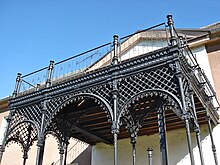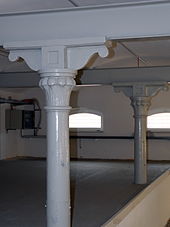cast iron
Cast iron is an iron material with a high carbon content ( mass fraction over 2%), which distinguishes this material from steel . Cast iron has good castability (low melting point, low viscosity melt, ...), but cannot be worked by forging because it is hard and brittle . Steel, on the other hand, is relatively difficult to cast, but it is very easy to forge. The machinability of cast iron depends on the exact grade; with cast iron with flake graphite - the most common type - it is good. Its strength is lower than that of cast steel , but the damping is higher.
properties
Cast iron is a group of iron- carbon alloys with a high proportion of carbon (> 2%). Many types also contain silicon , which improves castability, as well as other alloy components such as manganese , chromium or nickel . A distinction is made between
- gray cast iron ( gray cast iron ), in which the carbon occurs in the form of graphite . The fracture surfaces appear gray.
- white cast iron , in which the carbon occurs as a carbide in the form of cementite (Fe 3 C). The fracture surfaces are white.
The density of cast iron is about 7.2 g / cm³ and is lower than the density of steel or pure iron (7.85 g / cm³). At around 1150 ° C, the material has a significantly lower melting point than steel in the eutectic range , but it cannot be forged due to the high carbon content, which leads to high hardness and brittleness and low plasticity . The melt is thin, so it is easier to cast than the higher-viscosity steel melt. In foundries it is usually melted in a cupola furnace .
Cast iron parts are more resistant to corrosion than steel, especially if the cast skin is not damaged. The corrosion resistance can be increased by adding silicon, chromium and nickel to the alloy.
A simple method for checking the quality of gray cast iron is to hit a right-angled edge with a hammer : it should leave a lasting impression without the edge splintering.
sorts
The simplest and most common type of cast iron is cast iron with lamellar graphite (designation according to the current European standard EN 1561 "GJL" or earlier according to DIN 1691 "GGL"), in which the graphite is in the form of thin, irregularly shaped lamellae. These lamellas act as notches when subjected to tensile loads, so the tensile strength is relatively low (“ predetermined breaking points ”). In contrast to tensile strength, the transmission of compressive stress is much better. The compressive strength is about a factor of 4 higher than the tensile strength.
Due to the lack of mobility in the non-uniform structure with the graphite lamellae and internal stresses, gray cast iron has no recognizable plasticity - it is a brittle material with good thermal conductivity , good damping properties and, due to its brittleness, good dimensional stiffness . Therefore, gray cast iron is particularly suitable for machine beds and frames. In addition, there are advantageous self-lubricating properties if the lamellae can be cut through machining and the graphite itself or other lubricants in its place can be “stored” in the cavities.
| according to DIN EN 1561 | according to DIN 1691 |
|---|---|
| EN-GJL-150 | GG-15 |
| EN-GJL-200 | GG-20 |
| EN-GJL-250 | GG-25 |
| EN-GJL-300 | GG-30 |
| EN-GJL-350 | GG-35 |
Cast iron with spheroidal graphite (nodular cast iron, ductile cast iron, designation GJS according to the current European standard EN 1563, formerly GGG according to DIN 1693), in which the graphite is more or less spherical, has better mechanical properties . This is achieved by desulphurising the melt by adding small amounts of magnesium , cerium or calcium shortly before pouring.
Ductile cast iron is preferred for pipelines in centrifugal casting .
Another important form is malleable cast iron , which after solidifying as Ledeburite is subjected to another annealing treatment ( tempering ):
- With white malleable cast iron (GJMW), one anneals in an oxygen-releasing atmosphere, which removes the carbon from the castings (at least in the edge area), whereby the properties approach those of steel.
- Black malleable cast iron (GJMB) is annealed in an oxygen-free atmosphere. This leads to changes in the form of refinements in the structure, which have a positive effect on the mechanical properties of the workpiece. The improvements are not limited to the edge zone of the workpiece.
These varieties can also tolerate minor plastic deformations without breaking. Such materials are typically used as malleable cast iron fittings in pipeline construction for screwed connections.
A more recent material development is cast iron with vermicular graphite (designation GJV according to the current ISO 16112, previously GGV). With him, the graphite is neither lamellar nor spherical, but rather as lumps that look like worms in the micrograph (vermiculus, Latin for worms). The mechanical properties of this material lie between that of cast iron with lamellar graphite and those of cast iron with spheroidal graphite . However, it is more difficult to manufacture and requires a melt treatment that is performed within tight tolerances.
repair
The repair of cracked or broken castings is possible with the help of special procedures. In this way, metal bars can be pressed and caulked into chain holes made for this purpose across the course of the fracture or crack. In addition, threaded holes can be drilled in depth along the break line and screwed down with grub screws. The result is a non-positive and positive connection with high pressure tightness that prevents oils and gases from escaping.
literature
- Hans Berns, Werner Theisen: Iron materials - steel and cast iron . 4th edition. Springer, Berlin / Heidelberg 2008, ISBN 978-3-540-79955-9 .
- Peter Marks: European cast iron and cast steel grades = European Cast Iron and Steel Casting Grades . Ed .: DIN, German Institute for Standardization eV 2nd edition. Beuth, Berlin / Vienna / Zurich 2009, ISBN 978-3-410-17030-3 (= Beuth-Pocket. Werkstoffe ; text in German and English).
- Franz Neumann: Cast iron: melting technology, metallurgy, melting treatment . 2nd Edition. Expert, Renningen-Malmsheim 1999, ISBN 3-8169-1728-3 .
- Walter Hammer, Karin Michelberger, Wilfried Schremm: German cast iron ovens and stoves , Märchenofen Verlag, Ulm 1984, ISBN 3-9800967-0-X
- Eugen Piwowarsky : High quality cast iron - its properties and the physical metallurgy of its manufacture . 2nd Edition. Springer, Göttingen / Heidelberg 1958.
Web links
- Constructing and casting , online portal of the Federal Association of the German Foundry Industry
- Video of a casting process from melting to casting in sand molds (HD)
Individual evidence
- ↑ For example, the Iron Man in a forest near Bonn has been exposed to weather and soil moisture for a long time without any noticeable signs of corrosion.
- ↑ Metalock Engineering Germany . In: Hannes Hesse, Florian Langenscheidt, Hartmut Rauen (Eds.): Encyclopaedia of German Mechanical Engineering - The Best of German Engineering . VDMA-Verlag, Frankfurt am Main 2013, ISBN 978-3-8163-0628-3 , p. 521-523 .
- ↑ Patent DE1136163 : Pressure- tight connection of cracked or broken workpieces made of cast iron materials, especially gray cast iron. Published on October 15, 1957 , inventor: Rolf Joeres.







